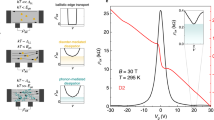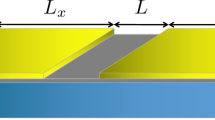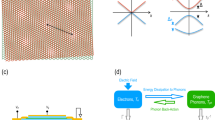Abstract
Carrier mobility in solids is generally limited by electron-impurity or electron–phonon scattering, depending on the most frequently occurring event. Three-body collisions between carriers and both phonons and impurities are rare; they are denoted supercollisions. Elusive in electronic transport they should emerge in relaxation processes as they allow for larger energy transfers. This is the case in undoped graphene, where the small Fermi surface drastically restricts the allowed phonon energy in ordinary collisions. Using electrical heating and sensitive noise thermometry we report on supercollision cooling in diffusive monolayer graphene. At low carrier density and high phonon temperature the Joule power P obeys a P Te3 law as a function of electronic temperature Te. It overrules the linear law expected for ordinary collisions which has recently been observed in resistivity measurements. The cubic law is characteristic of supercollisions and departs from the Te4 dependence recently reported for doped graphene below the Bloch–Grüneisen temperature. These supercollisions are important for applications of graphene in bolometry and photo-detection.
Te3 law as a function of electronic temperature Te. It overrules the linear law expected for ordinary collisions which has recently been observed in resistivity measurements. The cubic law is characteristic of supercollisions and departs from the Te4 dependence recently reported for doped graphene below the Bloch–Grüneisen temperature. These supercollisions are important for applications of graphene in bolometry and photo-detection.
This is a preview of subscription content, access via your institution
Access options
Subscribe to this journal
Receive 12 print issues and online access
$209.00 per year
only $17.42 per issue
Buy this article
- Purchase on Springer Link
- Instant access to full article PDF
Prices may be subject to local taxes which are calculated during checkout




Similar content being viewed by others
References
Castro Neto, A. H., Guinea, F., Peres, N. M. R., Novoselov, K. S. & Geim, A. K. The electronic properties of graphene. Rev. Mod. Phys. 81, 109–162 (2009).
Das Sarma, S., Adam, S., Hwang, E. H. & Rossi, E. Electronic transport in two dimensional graphene. Rev. Mod. Phys. 83, 407–470 (2012).
Efetov, D. K. & Kim, P. Controlling electron–phonon interactions in graphene at ultrahigh carrier densities. Phys. Rev. Lett. 105, 256805 (2010).
Song, J. C. W., Reizer, M. Y. & Levitov, L. S. Disorder-assisted electron–phonon scattering and cooling pathways in graphene. Phys. Rev. Lett. 109, 106602 (2012).
Bistritzer, R. & MacDonald, A. H. Electronic cooling in graphene. Phys. Rev. Lett. 102, 206410 (2009).
Tse, W-K. & Das Sarma, S. Energy relaxation of hot Dirac fermions in graphene. Phys. Rev. B 79, 235406 (2009).
Kubakaddi, S. S. Interaction of massless Dirac electrons with acoustic phonons in graphene at low temperatures. Phys. Rev. B 79, 075417 (2009).
Viljas, J. K. & Heikkilä, T. T. Electron–phonon heat transfer in monolayer and bilayer graphene. Phys. Rev. B 81, 245404 (2010).
Chaste, J. et al. Thermal shot noise in top-gated single carbon nanotube field effect transistors. Appl. Phys. Lett. 96, 192103 (2010).
Wu, F., Virtanen, P., Andresen, S., Plaçais, B. & Hakonen, P. J. Electron–phonon coupling in single-walled carbon nanotubes determined by shot noise. Appl. Phys. Lett. 97, 262115 (2010).
Fay, A. & Tomi, et al. Shot noise and conductivity at high bias in bilayer graphene: Signatures of electron-optical phonon coupling. Phys. Rev. B 84, 245427 (2011).
Betz, A. C. et al. Hot electron cooling by acoustic phonons in graphene. Phys. Rev. Lett. 109, 056805 (2012).
Baker, A. M. R, Alexander-Webber, J. A., Altebaeumer, T. & Nicholas, R. J. Energy relaxation for hot Dirac fermions in graphene and breakdown of the quantum Hall effect. Phys. Rev. B 85, 115403 (2012).
Wellstood, F. C., Urbina, C. & Clarke, J. Hot-electron effects in metals. Phys. Rev. B 49, 5942–5955 (1994).
Balandin, A. A. Thermal properties of graphene and nanostructured carbon materials. Nature Mater. 10, 569–581 (2011).
Bolotin, K. I., Sikes, K. J., Hone, J., Stormer, H. L. & Kim, P. Temperature-dependent transport in suspended graphene. Phys. Rev. Lett. 101, 096802 (2008).
Dean, C. R. et al. Boron nitride substrates for high-quality graphene electronics. Nature Nanotech. 5, 722–726 (2010).
Low, T., Perebeinos, V., Kim, R., Freitag, M. & Avouris, P. Cooling of photoexcited carriers in graphene by internal and substrate phonons. Phys. Rev. B 86, 045413 (2012).
Price, A. S., Hornett, S. M., Shytov, A. V., Hendry, E. & Horsell, D. W. Nonlinear resistivity and heat dissipation in monolayer graphene. Phys. Rev. B 85, 161411 (2012).
Gabor, N. M. et al. Hot carrier assisted intrinsic photoresponse in graphene. Science 334, 648–652 (2011).
Vora, H., Kumaravadivel, P., Nielsen, B. & Du, X. Bolometric response in graphene based superconducting tunnel junctions. Appl. Phys. Lett. 100, 153507 (2012).
Yan, J. et al. Dual-gated bilayer graphene hot-electron bolometer. Nature Nanotech. 7, 472–478 (2012).
Fong, K. C. & Schwab, K. C. Ultrasensitive and wide-bandwidth thermal measurements of graphene at low temperatures. Phys. Rev. X 2, 031006 (2012).
Graham, M. W., Shi, S-F., Ralph, D. C., Park, J. & McEuen, P. L. Photocurrent measurements of supercollision cooling in graphene. Nature Phys. http://dx.doi.org/10.1038/nphys2493 (2012).
Schneider, G. F., Calado, V. E., Zandbergen, H., Vandersypen, L. M. K. & Dekker, C. Wedging transfer of nanostructures. Nano Lett. 10, 1912–1916 (2010).
Pallecchi, E. et al. Graphene microwave transistors on sapphire substrate. Appl. Phys. Lett. 99, 113502 (2011).
Hooge, F. N., Kleinpenning, T. G. M. & Vandamme, L. K. J. Experimental studies on 1/f noise. Rep. Prog. Phys. 44, 479–532 (1981).
Acknowledgements
The research has been supported by the contracts ANR-2010-BLAN-MIGRAQUEL, SBPC and Cnano-2011 Topin’s and Grav’s.
Author information
Authors and Affiliations
Contributions
A.C.B. and S.H.J. conducted the noise measurements; R.F. performed the calculations of the supercollisions; E.P. participated in the early stage of the experiment. G.F. and J-M.B. supported the experiments; S.H.J. and B.P. wrote the paper; and B.P. initiated the experiment.
Corresponding authors
Ethics declarations
Competing interests
The authors declare no competing financial interests.
Rights and permissions
About this article
Cite this article
Betz, A., Jhang, S., Pallecchi, E. et al. Supercollision cooling in undoped graphene. Nature Phys 9, 109–112 (2013). https://doi.org/10.1038/nphys2494
Received:
Accepted:
Published:
Issue Date:
DOI: https://doi.org/10.1038/nphys2494
This article is cited by
-
Electron–phonon coupling in copper intercalated Bi\(_{2}\)Se\(_{3}\)
Scientific Reports (2022)
-
Interaction-driven giant thermopower in magic-angle twisted bilayer graphene
Nature Physics (2022)
-
Hydrodynamic approach to two-dimensional electron systems
La Rivista del Nuovo Cimento (2022)
-
Angle-tunable intersubband photoabsorption and enhanced photobleaching in twisted bilayer graphene
Nano Research (2021)
-
Graphene-based Josephson junction microwave bolometer
Nature (2020)



